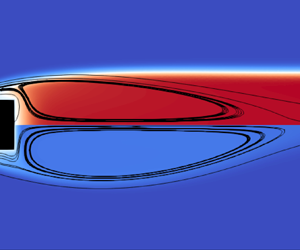Article contents
Global linear stability analysis of a flame anchored to a cylinder
Published online by Cambridge University Press: 10 November 2022
Abstract

This study investigates the linear stability of a laminar premixed flame, anchored on a square cylinder and confined inside a channel. Many modern linear analysis concepts have been developed and validated around non-reacting bluff-body wake flows, and the objective of this paper is to explore whether those tools can be applied with the same success to the study of reacting flows in similar configurations. It is found that linear instability analysis of steady reacting flow states accurately predicts critical flow parameters for the onset of limit-cycle oscillations, when compared to direct numerical simulation performed with a simple one-step reaction scheme in the low Mach number limit. Furthermore, the linear analysis predicts a strong stabilising effect of flame ignition, consistent with documented experiments and numerical simulations. Instability in ignited wake flows is, however, found to set in at sufficiently high Reynolds number, and a linear wavemaker analysis characterises this instability as being driven by hydrodynamic mechanisms of a similar nature as in non-reacting wake flows. The frequency of nonlinear limit-cycle flame oscillations in this unstable regime is retrieved accurately by linear eigenmode analysis performed on the time-averaged mean flow, under the condition that the full set of the reacting flow equations is linearised. If, on the contrary, unsteadiness in the density and in the reaction rate are excluded from the linear model, then the congruence between linear and nonlinear dynamics is lost.
JFM classification
Information
- Type
- JFM Papers
- Information
- Copyright
- © The Author(s), 2022. Published by Cambridge University Press.
References
- 8
- Cited by


